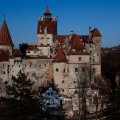BRAN CASTLE
Its imposing silhouette stands on a rocky outcrop, at the bend of a valley winding between the Bucegi and Piatra Craiului mountains. Bran Castle, steeped in history and legend, is one of Romania's top tourist attractions. It attracts hundreds of thousands of visitors every year to discover Dracula's supposed castle, or at least that of Vlad Țepeș, the 15th-century Wallachian prince on whom writer Bram Stoker is said to have based his vampire character. While it resembles the count's home described in Stoker's novel, the castle has no proven connection with Vlad Țepeș. In fact, it has much more to do with Queen Marie, adored by the Romanians, who left her mark on the place between the wars.
Built between 1377 and 1382 by the inhabitants of Brașov, by order of the King of Hungary, Bran Castle occupied a strategic position. Its function was to defend Transylvania against Ottoman attacks. It also acted as a customs post between Transylvania and Wallachia until 1836. The town of Brașov, which owned the site, donated it to Queen Marie in 1920, in gratitude for her commitment to the country in the First World War. On her death in 1938, the castle was bequeathed to her daughter Ileana. Confiscated by the Communists, it was finally returned to Ileana's heirs, the Habsburg family, in 2006.
The medieval castle, built in Gothic style, has undergone several changes over the centuries, as evidenced by its convoluted architecture. From a single tower, it now boasts four. The extensive restoration work undertaken in the 1920s by Queen Marie, in collaboration with Czech architect Karel Liman, significantly altered the premises, giving them a romantic feel.
Elegant reception rooms and comfortable bedrooms were created. All nooks and alcoves, the rooms are spread over four levels, accessed by staircases that form a maze, conducive to exploration. A secret passageway has even been uncovered in the former council chamber. From the loopholes transformed into windows, the view of the surrounding countryside is spectacular.
Queen Marie also laid out a beautiful park at the foot of the château. You can enjoy a meal in the queen's former tea house, now a pleasant restaurant. The elevator built in 1937 to link the castle and the park was restored in 2017. You have to pay extra to borrow it and enjoy an interactive multimedia exhibition: in our opinion, you can skip it. A visit to the torture chamber, which also costs extra (€4), isn't essential either.
Tourists who have come for Dracula won't leave empty-handed: a number of rooms are devoted to the vampire myth and the story of his inspiration Vlad Țepeș. You'll also learn more about strigoi, the undead of Romanian folklore.
Bran Castle may be a little irritatingly draculomaniac, but it's nonetheless an exceptional monument, full of soul. However, avoid peak periods in summer and on Sundays, or aim for the early or late hours of the day: the crowds can make the visit a real pain. Signs are in English and Romanian, but a French audioguide is available for a small extra charge.
Did you know? This review was written by our professional authors.
Book the Best Activities with Get Your Guide
Members' reviews on BRAN CASTLE
The ratings and reviews below reflect the subjective opinions of members and not the opinion of The Little Witty.


on reste sur sa fin, mais intéressant quand même